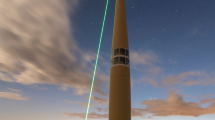Abstract
IT has long been known that the ordinary spark discharge between spherical electrodes exhibits numerous side-branches which are forked away from the positive pole. Similar branching, almost always directed downwards, is shown by lightning discharges between a thundercloud and the ground. For this reason it has been concluded that the direction of branching in a lightning flash is a criterion of the polarity of the discharge (Walter and Simpson). Simpson has examined some five hundred photographs of lightning and has concluded that at least 80 per cent of these pass from a positively charged cloud-base.
This is a preview of subscription content, access via your institution
Access options
Subscribe to this journal
Receive 51 print issues and online access
$199.00 per year
only $3.90 per issue
Buy this article
- Purchase on Springer Link
- Instant access to full article PDF
Prices may be subject to local taxes which are calculated during checkout
Similar content being viewed by others
References
Gen. Elect. Rev., vol. 34, 8.
Author information
Authors and Affiliations
Rights and permissions
About this article
Cite this article
SCHONLAND, B., ALLIBONE, T. Branching of Lightning. Nature 128, 794–795 (1931). https://doi.org/10.1038/128794a0
Issue Date:
DOI: https://doi.org/10.1038/128794a0
Comments
By submitting a comment you agree to abide by our Terms and Community Guidelines. If you find something abusive or that does not comply with our terms or guidelines please flag it as inappropriate.



